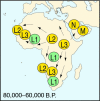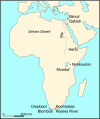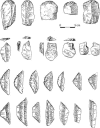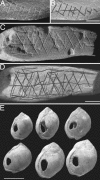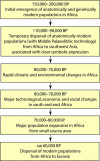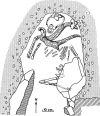Why did modern human populations disperse from Africa ca. 60,000 years ago? A new model - PubMed (original) (raw)
Why did modern human populations disperse from Africa ca. 60,000 years ago? A new model
Paul Mellars. Proc Natl Acad Sci U S A. 2006.
Erratum in
- Proc Natl Acad Sci U S A. 2006 Sep 5;103(36):13560
Abstract
Recent research has provided increasing support for the origins of anatomically and genetically "modern" human populations in Africa between 150,000 and 200,000 years ago, followed by a major dispersal of these populations to both Asia and Europe sometime after ca. 65,000 before present (B.P.). However, the central question of why it took these populations approximately 100,000 years to disperse from Africa to other regions of the world has never been clearly resolved. It is suggested here that the answer may lie partly in the results of recent DNA studies of present-day African populations, combined with a spate of new archaeological discoveries in Africa. Studies of both the mitochondrial DNA (mtDNA) mismatch patterns in modern African populations and related mtDNA lineage-analysis patterns point to a major demographic expansion centered broadly within the time range from 80,000 to 60,000 B.P., probably deriving from a small geographical region of Africa. Recent archaeological discoveries in southern and eastern Africa suggest that, at approximately the same time, there was a major increase in the complexity of the technological, economic, social, and cognitive behavior of certain African groups, which could have led to a major demographic expansion of these groups in competition with other, adjacent groups. It is suggested that this complex of behavioral changes (possibly triggered by the rapid environmental changes around the transition from oxygen isotope stage 5 to stage 4) could have led not only to the expansion of the L2 and L3 mitochondrial lineages over the whole of Africa but also to the ensuing dispersal of these modern populations over most regions of Asia, Australasia, and Europe, and their replacement (with or without interbreeding) of the preceding "archaic" populations in these regions.
Conflict of interest statement
Conflict of interest statement: No conflicts declared.
Figures
Fig. 1.
mtDNA “mismatch” distributions of present-day African, Asian, and European populations, showing the frequency distribution of differences between pairs of individuals in the three populations. The modes of the three distributions clearly reflect a much earlier demographic expansion of African populations (ca. 80,000 B.P.), than those in Asia (ca. 60,000 B.P.) and Europe (ca. 40,000 B.P.) (–25).
Fig. 2.
Inferred patterns of geographical dispersal of the L2 and L3 mtDNA lineages in Africa between ca. 80,000 and 60,000 B.P., according to Forster (2). Later dispersals of the M, N, and R lineages into Asia and Europe after 65,000 B.P. derive from the L3 lineage.
Fig. 3.
Map of archaeological sites and early anatomically modern human remains in Africa and Israel, referred to in text.
Fig. 4.
Stone tools from the MSA Howiesons Poort levels at Klasies River (South Africa) dated to ca. 65,000 B.P., showing closely similar forms of blades, end scrapers, burins, and small, hafted segment forms to those found in European and Asian Upper Palaeolithic sites from ca. 45,000 B.P. onwards (32).
Fig. 5.
Fragments of red ochre incised with a complex geometrical design (A_–_D), and a series of deliberately perforated shells of Nassarius kraussianus (E) from the MSA levels of the Blombos Cave (South Africa), dated to ca. 75,000 B.P. (38, 39). [A_–_D reproduced with permission from Henshilwood et al. (38) (Copyright 2002, AAAS). E reproduced with permission from Henshilwood et al. (104) (Copyright 2004, AAAS).]
Fig. 6.
Summary of the model proposed here for modern human origins and dispersal from Africa.
Fig. 7.
Burial of an anatomically modern human skeleton at the Qafzeh Cave (Israel), accompanied by a large deer antler and dated to ca. 90,000–100,000 B.P. (73, 74).
Similar articles
- Going east: new genetic and archaeological perspectives on the modern human colonization of Eurasia.
Mellars P. Mellars P. Science. 2006 Aug 11;313(5788):796-800. doi: 10.1126/science.1128402. Science. 2006. PMID: 16902130 - Genetic and archaeological perspectives on the initial modern human colonization of southern Asia.
Mellars P, Gori KC, Carr M, Soares PA, Richards MB. Mellars P, et al. Proc Natl Acad Sci U S A. 2013 Jun 25;110(26):10699-704. doi: 10.1073/pnas.1306043110. Epub 2013 Jun 10. Proc Natl Acad Sci U S A. 2013. PMID: 23754394 Free PMC article. - The Expansion of mtDNA Haplogroup L3 within and out of Africa.
Soares P, Alshamali F, Pereira JB, Fernandes V, Silva NM, Afonso C, Costa MD, Musilová E, Macaulay V, Richards MB, Cerny V, Pereira L. Soares P, et al. Mol Biol Evol. 2012 Mar;29(3):915-27. doi: 10.1093/molbev/msr245. Epub 2011 Nov 16. Mol Biol Evol. 2012. PMID: 22096215 - Archaic human genomics.
Disotell TR. Disotell TR. Am J Phys Anthropol. 2012;149 Suppl 55:24-39. doi: 10.1002/ajpa.22159. Epub 2012 Nov 2. Am J Phys Anthropol. 2012. PMID: 23124308 Review. - Human evolution: the southern route to Asia.
Disotell TR. Disotell TR. Curr Biol. 1999 Dec 16-30;9(24):R925-8. doi: 10.1016/s0960-9822(00)80106-2. Curr Biol. 1999. PMID: 10607580 Review.
Cited by
- The HIV-1 pandemic: does the selective sweep in chimpanzees mirror humankind's future?
de Groot NG, Bontrop RE. de Groot NG, et al. Retrovirology. 2013 May 24;10:53. doi: 10.1186/1742-4690-10-53. Retrovirology. 2013. PMID: 23705941 Free PMC article. Review. - Divergence and recombination of clinical herpes simplex virus type 2 isolates.
Norberg P, Kasubi MJ, Haarr L, Bergström T, Liljeqvist JA. Norberg P, et al. J Virol. 2007 Dec;81(23):13158-67. doi: 10.1128/JVI.01310-07. Epub 2007 Sep 19. J Virol. 2007. PMID: 17881457 Free PMC article. - The dawn of human matrilineal diversity.
Behar DM, Villems R, Soodyall H, Blue-Smith J, Pereira L, Metspalu E, Scozzari R, Makkan H, Tzur S, Comas D, Bertranpetit J, Quintana-Murci L, Tyler-Smith C, Wells RS, Rosset S; Genographic Consortium. Behar DM, et al. Am J Hum Genet. 2008 May;82(5):1130-40. doi: 10.1016/j.ajhg.2008.04.002. Epub 2008 Apr 24. Am J Hum Genet. 2008. PMID: 18439549 Free PMC article. - Recently evolved human-specific methylated regions are enriched in schizophrenia signals.
Banerjee N, Polushina T, Bettella F, Giddaluru S, Steen VM, Andreassen OA, Le Hellard S. Banerjee N, et al. BMC Evol Biol. 2018 May 11;18(1):63. doi: 10.1186/s12862-018-1177-2. BMC Evol Biol. 2018. PMID: 29747567 Free PMC article.
References
- Tishkoff S. A., Williams S. M. Nat. Rev. Genet. 2002;3:611–621. - PubMed
Publication types
MeSH terms
Substances
LinkOut - more resources
Full Text Sources

